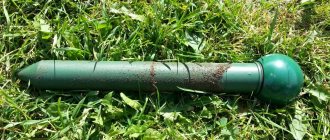Hello! I would like to share with you my own experience in “expelling” moles from my site. And since we have already met, this experience will definitely be useful to you!
I’ll admit in advance: fighting moles at my dacha turned out to be not an easy task, since I had no personal knowledge in the field of “moleology”, and I had to rely solely on virtual advisers. And the Internet, if you look, is literally replete with all sorts of ways and methods, one more effective and simpler than the other!
So, I propose to move from words to action and, first of all, clarify a little who the “moles” are and what kind of animal they are.
DIY mole repellers
It is difficult to meet owners of summer cottages or household plots who would not encounter such a problem as the appearance of moles. Most owners do not want to deal with chemicals, which are already used in abundance. Therefore, they use quite simple but effective devices that repel these underground diggers. It should be noted that mole repellers can be bought in stores, as well as made with your own hands from improvised, and sometimes unnecessary, materials on the farm.
Classification of mole repellers: criteria for selecting devices
The popularity of mole repellent device models depends on their effective impact on these mammals. For years, gardeners have used various tricks: folk remedies, mole traps, drugs and special devices made with their own hands, but not everyone got the desired result. Today there are methods without damage to the garden and pets, new devices have appeared that work according to certain methods. It’s up to you to decide which repeller is best to buy. The table shows the main types of these devices.
Table - “Types of modern mole repellers for 2022”
| Name: | Classification: | Description: |
| Based on the operating principle: | ultrasonic | vibrations created by an ultrasonic emitter that are inaccessible to human hearing |
| mechanical | produces mechanical vibrations | |
| biological | spread of a specific odor | |
| By battery: | battery operated | require replacement, wear out quickly |
| network | work from a power cord | |
| solar | Charged by sunlight, no limitation on service life | |
| According to the material: | metal | often combine plastic and metal |
| plastic | ||
| wood | homemade devices | |
| Installation: | stationary | in room |
| street | Location on | |
| By cost: | expensive | modern devices |
| inexpensive | live traps | |
| free | made with your own hands |
Popular models among anti-mole devices are sound devices. What to pay attention to when purchasing them:
- Radius of action;
- Wave power;
- Battery;
- Customer reviews;
- Where used (indoors, outdoors);
- Simple installation diagram;
- Which company is better?
- Cost of the device.
Devices of this type are inexpensive, but you can buy them even cheaper: order them on Ali Express or make them yourself.
Repellers made from plastic bottles
A bottle placed on a pin is the design of the simplest repeller. The same structure can be made from empty beer cans. The pin must be stuck into the ground so that the vibrations from the repeller are transmitted into the thickness of the earth.
Interesting fact! An iron pin is much more effective than a wooden one, since metal transmits sound waves better.
A windmill against moles is a more complex design. To make it you will need a beer bottle with a capacity of up to one and a half liters.
It is important to know! A high-quality repeller can be made from an ordinary beer bottle with a narrow, elongated neck.
To make a windmill, you need to have some more tools, such as scissors, a marker, a self-tapping screw, a nail, an awl and a pin (stick). As a rule, there are no ready-made diagrams and drawings, since the device is quite simple. In addition, there is a video where you can clearly see, frame by frame, the methodology for making such a repeller.
- You need to cut off the bottom of the bottle along the line that can be found on the bottle.
- The cut bottom should be turned upside down, resulting in the shape of a five-pointed star. Use a marker to mark the areas to be cut. A section is cut out from the center of the bottom, both in the middle of the “star” beam and along the depressions located between the beams.
- The same operation should be carried out on all rays. The result should be a kind of propeller. After this, a hole is punched in the center of the bottom. Since the product is intended for rotation, the hole should not have burrs. In addition, the diameter of the hole should be slightly larger than the diameter of the screw.
- This propeller is screwed using a self-tapping screw to the bottle cap (the same one), and strictly in the center. To simplify this task, first make a thin hole in the lid. For reliability, the self-tapping screw is fixed on the inside of the lid with a kind of nut made of any material.
- From the bottom of the bottle neck, 2 holes are made strictly opposite each other.
- At the final stage, the windmill is taken and secured to a wooden stick, after which the entire structure is stuck into the ground where necessary.
Under the influence of wind force, the structure makes an unpleasant sound, which negatively affects moles. The advantage of the design is that the windmill turns automatically, depending on the direction of the wind.
To drive the mole away from the site, it is enough to make a simpler design. To do this, you need to take a plastic bottle and simply place it on a wooden stick. Below you can see what this design looks like.
You can enhance the effect of such a design if you bury a metal pipe in the ground at a level below the molehills. After this, a pin with a windmill is installed in the pipe. To prevent this pin from dangling, it is fixed in the pipe. It is better if the design works regardless of wind direction. To do this, special blades are cut into the sides of the bottle and bent outward.
Rating of high-quality sound mole repellers for 2022
The best manufacturers of this category of steel companies:
- "EcoSniper";
- "RemiLing";
- "Grad";
- Boyscout;
- "TORNADO";
- "31st CENTURY".
Model "LS-997R" from
Purpose: against moles and rodents, as well as insects.
The device resembles a large nail with a plastic cap. It runs on batteries, and depending on the use of the device, the batteries need to be changed regularly. One such device is enough to operate 45 meters in diameter. If the area is huge, then several repellers are installed at a distance of 30-40 meters from each other.
Packaging and appearance of the mole repeller model “LS-997R” from
Specifications:
| Action area (sq. meters): | 1500 |
| Size (centimeters): | 41,5/6,5/6,5 |
| Net weight: | 420 g |
| Frequency: | 300-400 Hz |
| Battery: | battery, 4 pcs., type “D” |
| Material: | made of metal + plastic elements |
| By price: | 1600 rubles |
LS-997R EcoSniper
Advantages:
- Efficient device;
- The repeller is easy to use;
- The range of one device is enough for 12 acres;
- Holds a charge for a long time;
- Universal model: not only against moles;
- Durable design;
- Inexpensive.
Flaws:
- Not for sub-zero temperatures: it is recommended to remove if the soil is frozen;
- Sound is blocked by obstacles such as foundations, concrete walkways, and tree roots.
Model "Terminator D03" from
Purpose: from moles and mice, as well as snakes.
Repellers from a Chinese manufacturer begin to work on solar energy after turning on the button on the panel. It is stuck into the soil 3/4 of the entire device. It is advisable to place it in a well-lit area so that the sun recharges the battery charge. The durable body consists of metal and plastic, the appearance is like a nail.
Packaging and appearance of the mole repeller “Terminator D03” from
Specifications:
| Covered area (sq. meters): | 700 |
| Nutrition: | solar powered |
| Frame: | plastic, metal |
| Radius of action: | 35 meters |
| Where is the company from: | from China |
| Net weight: | 120 g |
| Size (centimeters): | 25/6 |
| Average price: | 700 rubles |
Terminator D03 RemiLing
Advantages:
- Environmentally friendly device;
- Effective;
- Safe;
- Inexpensive;
- Repels ants;
- Does not require a change in power supply: charges from sunlight;
- Lightweight;
- Small size.
Flaws:
- Not identified.
Model "A-500" from
Purpose: against moles and rodents.
The indoor device operates from the network. Universal: you can insert AAA batteries, but the range of action will be 2 times less. Outwardly it looks like a rectangular box equipped with various holes. Black body. There is a round speaker from which sound waves come out in a chaotic manner.
Model "A-500" from, mole repeller, appearance of the device
Specifications:
| Parameters (centimeters): | 10,5/5,8/1,9 |
| Net weight: | 120 g |
| Area coverage (sq. meters): | 500 |
| Nutrition: | from 220 V network |
| Manufacturer: | Russia |
| When operating on batteries or an “AAA” battery, covers the area (sq. meters): | 250 |
| Connection adapter: | 9 V |
| Required number of batteries: | 3 pcs. |
| What is the price: | 2000 rubles |
A-500 Grad
Advantages:
- Sound frequencies are constantly changing, so moles will not be able to adapt to the action of the device;
- High efficiency;
- Can be left on around the clock;
- Sufficient capture area to protect the area from pests;
- Device design;
- Value for money;
- Regardless of weather conditions, it copes with the task perfectly;
- Can run on batteries.
Flaws:
- Not identified.
Model "80411 HELP" from
Purpose: against moles and shrews.
A device that looks like a sunflower. Charges from sunlight. The rod is metal, the cap is plastic. A device for outdoor use will complement the area with bright colors. Provides illumination at night thanks to the built-in LED flashlight.
Model design "80411 HELP" from
Specifications:
| Operating area (sq. meters): | 800 |
| Dimensions (centimeters): | 16,3/36 |
| Operating Frequency: | 400-1000 kHz |
| Frame: | aluminum, plastic |
| Nutrition: | solar battery |
| Battery type: | 1.2V/300mAH Ni-cd |
| Manufacturer country: | China |
| Average cost: | 1120 rubles |
80411 HELP Boyscout
Advantages:
- Ergonomic design;
- The device is safe for pets, insects and people;
- Certified;
- Unlimited validity period;
- Copes with the task perfectly;
- Covers a large area;
- An additional accessory for a summer cottage.
Flaws:
- Avoid exposure to moisture: store only in a dry place.
Model "OZV.02" from
Purpose: against moles and snakes, as well as other rodents.
The appearance of the device resembles a huge sharpened pencil. The body is black, the valve cap is green. The case is durable, water-repellent, and allows operation in any weather conditions, except for freezing temperatures. Repels all pests living underground.
Model "OZV.02" from, unpacked
Specifications:
| Action area (sq. meters): | 2000 |
| Frame: | ABS plastic |
| Nutrition: | on batteries, 4 pcs. |
| Operating time until next power change: | 3 months |
| Result: | after 4 weeks |
| Radiated frequencies (Hz): | -100; 400+ |
| Ultrasonic pressure: | 72 dB at 1 meter |
| Operating temperature range: | 0-50 with a “+” sign |
| Net weight: | 200 g |
| Parameters (centimeters): | 6,7/6,7/38,5 |
| Pause exposure: | 45-50 seconds |
| Buzzer vibration length: | 10-15 seconds |
| Average price segment: | 900 rubles |
ZV.02 TORNADO
Advantages:
- Functional;
- Protective housing from moisture;
- Inexpensive;
- Design;
- Range of operation of one device;
- Battery holds a charge for a long time;
- Effective: after the specified time, there is no trace of the presence of pests;
- Two types of influence: mechanical, ultrasonic.
Flaws:
- Works only at positive or neutral temperatures;
- You need to buy the batteries yourself.
Model "GH-316" from
Purpose: to combat earthen rodents.
A small “nail” in height, on the head of which there is a solar battery. Affects a depth of up to 20 centimeters. The rod is made of aluminum, so it will not rust if it gets wet. To get quick results, you can use several of these devices. The device is endowed with high operating frequency and territory coverage.
Model "GH-316" from, appearance
Specifications:
| Manufacturer: | China |
| Action area (sq. meters): | 700 |
| Frequencies (Hz): | 400-1000 |
| Vibration interval: | 30-50 seconds |
| Dimensions (centimeters): | 33/15,5/15,5 |
| Net weight: | 310 g |
| Material: | made of plastic and metal |
| Nutrition: | from sunlight |
| Price: | 1600 rubles |
GH-316 31st CENTURY
Advantages:
- Safe device;
- Copes with the task;
- Durable housing;
- No operating restrictions;
- Does not need to replace batteries;
- Value for money.
Flaws:
- Not identified.
How to get rid of a mole on your property. Alarm clocks, homemade vibration repeller and pit traps
For the fourth day now, having given up everything I was doing, I was just working on the mole. It hasn't been there yet. Apparently it came from a neighbor downstairs.
Unfortunately, our herd does not catch moles. You have to do the fishing yourself. How to get rid of moles on your site? I’ll tell you below about the methods that I tested and gave results.
What I do in the morning to eliminate the consequences of a mole invasion:
⚫1. I urgently eliminate the consequences in the vegetable beds themselves: I first compact the soil with my hands where he walked, especially around the plants, because their roots hang in the air and if you don’t compact the soil at least around them, the plants will die. After burying its passages in the garden bed, I spill it very generously with water so that the soil settles.
⚫2. I look for mole entrances into the garden bed and stick sharp pegs into them deeper so that they don’t come here a second time. Of course, this is a half-measure, because he will go a little further and make an approach in a different place, but still.
⚫3. I also plug the mole’s entrances inside the greenhouse with a peg, but this entrance must also be found outside. The mole doesn’t bother digging the ground if it is possible to walk on the surface, but it is important for him that there is some kind of covering (for example, a path or boards covered with sawdust). It turned out exactly the same here: the entrance to the greenhouse was under a plank.
⚫4. In the place where he twice entered the greenhouse, I planted a cucumber. It is still small, but twice the mole dug it up and threw it up with its roots. I'm crying! To eliminate this entry from the outside, I dug a ditch deeper along the greenhouse (the mole does not go deep) and buried a fence so that he would stick into it.
I have only one such unprotected greenhouse (the oldest one), because when we installed the last greenhouse, we immediately made vertical fences from corrugated sheets specifically to prevent moles.
I never had problems with moles on my old site. Only here I had to master methods of fighting moles, from the simplest (herring and kerosene) to complex (vibration repeller).
And in the average (in time) greenhouse, I laid a net in the beds two years ago. Moles poke at it, but cannot get through.
In the open ground, in the beds, the moles, of course, have complete freedom, although we installed a turntable for each of them, but the wind does not always blow. By the way, tonight was very quiet and windless, maybe that’s why the moles found the opportunity to do more shit?
Dossier: mole
I don’t know about you, but personally, against the backdrop of all the cartoons I watched as a child, the mole seemed like some kind of touching animal. And when I saw the characteristic mounds on my site, I even felt a semblance of delight, oddly enough.
Don’t repeat my mistakes - there is absolutely nothing touching about this underground animal!
- 100% the mole came to you not alone, but with a whole family, which extremely rarely numbers less than 5 individuals, which, naturally, significantly complicates your confrontation;
- Moles spend the whole year underground. In winter, they hibernate, digging a larger hole for themselves and, as a rule, on a hill or other elevation - so that the sun warms up earlier and the snow melts away faster;
- In fact, all the “labyrinths” built by moles, and they can be simply immeasurable, are located no deeper than 20 cm from the surface - precisely in the so-called “fertile” layer. However, since this animal is a carnivore, it is not at all interested in roots. But larvae, worms, etc. - what you need;
- The activity of the beast is extremely high - you can push its progress, do it regularly and wait for it to appear. But, as soon as you turn away for a moment, the move is already restored;
- Moles move through their burrows very, very quickly. An obstacle or, for example, a destroyed passage is most often “bypassed” from below, less often from the side. Very rarely, although it happens that they crawl out and cross the barrier, despite the fact that moles supposedly cannot stand open space;
- Taking into account the mole's lifestyle, do not even try to catch it with your own hands, much less pick it up with them. A mole is essentially a lump of muscle that constantly feeds on proteins. You definitely won’t be able to hold it, but being bitten or scratched is welcome!
Alarm clock from moles
We also tried mole alarms in previous years. They buried the clocks in jars with a metal lid in three greenhouses, setting the alarm clock for the same time in the morning. The mole still walked, only in the evening.
Then they set the alarm clock at different times in three greenhouses: in one in the morning, in another at noon, in the third in the evening. So this “g-sh” came in the morning to that greenhouse where the clock worked in the evening and vice versa. In short, I worked by the hour.
This method is good as an additional method to the vibration repeller.
The alarm clock goes off twice a day at the set number (one alarm clock will turn on at 5 am and at 17-00, and the second at 12 noon and at 24-00) and rings for an hour. Taking into account the operation of the vibrating mole repeller (in the morning from 8 to 10 and in the evening from 19 to 22), it turns out that the mole has very little time left.
Setting up a rodent repeller
If all radio components are in working order and installation is error-free, the mole repeller will work immediately. If desired, you can change the time parameters of the emitted sound signal. The frequency will increase as resistor R1 or capacitor C1 decreases. If there is a desire to change the frequency during operation of the mole repeller, then resistor R1 can be replaced with two series-connected, permanent and trimming resistors with a nominal value of 75 kOhm. When changing the frequency of the clock generator, it is necessary that it remains in the range from 300 to 900 Hz, since these are the sound frequencies that most effectively drive away rodents.
When changing the frequency of the generator, it is necessary to take into account that the repetition period of sound signals will also change proportionally. For example, if the frequency is set twice as low - 250 Hz, then the time between sound signals and the duration of the signal will also become twice as long, 64 seconds and 4 seconds, respectively. So there is an opportunity to experiment here. If desired, you can restore the previous timing parameters by transferring the diode anode from pin 3 of DD2 to pin 14.
The duration of the sound signal and the period of its repetition can be easily changed. If you remove the diode from pin 15 of DD2, then the duration of the sound signal will be 4 seconds without changing the repetition period of 32 seconds, and if you add an additional diode from pin 14 of DD2 to pin 12 of DD1.3, then the sound signal will last 1 second.
Pit traps for moles
Today I also urgently made pit traps for moles. I tried such pits between plants for the first time last year, but for a completely different purpose: to feed tomatoes. But it turned out that the moles, climbing into the greenhouse, hung out only in these holes, without plowing the entire garden bed, and my tomatoes were not touched by them.
Dig a hole between the planted crops the size of a spade bayonet in all directions and the same depth and fill it with freshly cut grass. All watering during the season is also done in pits.
In such pits for feeding plants, of course, it is warm, humid and worms breed, so moles came only to them, as if to a buffet.
Last year I concluded that in this (unprotected) greenhouse it is necessary to make such pits with grass specifically for moles, but in the spring I didn’t do it when planting, but now I repent.
Today I urgently dug several holes between the tomatoes with a garden scoop, smaller in size than for feeding plants, but normal for moles.
What else can you do? Please advise how to get rid of moles on your property? Maybe someone has a proven method.
If you liked the article, put a LIKE and subscribe to the channel to read new posts.
Mole: useful or harmful?
It would seem that if you knew what moles eat, you wouldn’t have to worry about your garden. On the one hand, you are, of course, right. But look at the photo... This is the result of the activities of one, so to speak, family. Moreover, while “working” in the fertile layer, these diggers destroy the root system of plants.
But on the other hand... For example: the metro was built by metro builders, but they are not the only ones who use it! It’s the same here: it’s not only moles that travel on their own highways. But such travelers as, for example, a field mouse or some kind of gopher - this is already a campaign that will deal with your roots with great appetite!
Here, in fact, is the answer to the question: is this mole a useful or harmful animal? Although it is believed that they live only in good, fertile soil. Perhaps this is the only advantage of their appearance - the realization that your land is miraculously good.
I hope I have enlightened you a little and, most importantly, convinced you that fighting moles is a necessary necessity.
Options from plastic bottles
The simplest version of a homemade repeller is a bottle placed on a pin. Also suitable for empty beer cans. The pin must be stuck into the ground so that sound and vibration are transmitted to the wormholes.
Iron transmits sound better than wood.
The most difficult option is a windmill against moles. To make it you will need a one and a half liter beer bottle.
The bottle must be of a “classic” beer shape. That is, with a narrow elongated neck.
In addition to the bottle, you need good scissors, a marker, a self-tapping screw with threads that do not reach the head, a nail, an awl and a windmill stick. Given the maximum complexity of creating such a mole repeller from a plastic bottle, there are no visual diagrams or drawings. There is only an extremely clear video.
- The bottom of the bottle is cut off along the horizontal line that is found on all plastic bottles.
- The cut bottom is turned over with the bottom up. The bottom has the shape of a five-rayed star. Using a marker, mark the areas that need to be cut out: from the border of the central circle strictly in the middle of the “ray” and from the middle of the central circle along the hollow between the “rays”. This part needs to be cut off. It turns out that half of the “beam” is cut out.
- The operation is repeated on all “rays”. The propeller is ready. All that remains is to punch a hole strictly in the center of the circle. The hole should have perfectly smooth edges and a diameter larger than the provided screw.
- Insert a self-tapping screw with the head “inward” into the resulting propeller and screw it into the center of the bottle cap until the thread runs out. To make screwing easier, you first need to make a small hole in the cap. On the inside of the cover, the self-tapping screw can be secured with a nut for reliability.
- Make two holes for a nail at the bottom of the bottle neck, strictly along the center line. The holes must be strictly opposite each other.
- Take an almost finished windmill and secure it to a wooden pole. Stick the pole into the ground in the garden.
When there is wind, the propeller makes a rather nasty noise, which moles are afraid of. The advantage of a windmill is that it will work in any wind direction. In fact, this is an ordinary weather vane.
It’s not difficult to make your life easier and drive the mole out of the garden. To do this, you need to make a pinwheel from a plastic bottle to scare away moles without any special frills, mounted on a pin. The diagram of such a turntable is below.
Design and device
My friend, a big fan of growing vegetables on his own plot, Ivanov Gennady Vasilievich, came up with the design, manufactured and tested in practice the effectiveness of four devices for repelling moles. The design is very simple to manufacture and requires virtually no financial costs. Gennady Vasilyevich kindly provided me with one of the devices for repelling moles for the preparation of this article.
The body for the mole repeller device was a metal can of dry cat food, which contains all the parts. The jar is hermetically sealed with a plastic lid and prevents water from getting into it from rain and when watering the garden. To make a mole repeller, any metal hermetically sealed can of a suitable size, for example a coffee can, is suitable.
The TK-67-NT telephone capsule, which is widely used in landline telephone handsets, is used as a sound wave emitter in the repeller. This is a simple and reliable emitter and can be taken from any old phone. The capsule emits sound well in the frequency range from 300 to 3400 Hz, which is exactly what is needed, and has an electrical impedance module at a frequency of 1000 Hz, 260 ± 52 Ohms. And most importantly, the capsule made it possible to easily solve the problem of sealing the case and at the same time greatly increase the efficiency of the mole repeller due to its original installation in the case.
The cap is unscrewed from the primer, the metal membrane is removed (pictured on the left), and it is simply attached to the bottom of the can (pictured on the right). To prevent the capsule from moving along the bottom of the can, its body is fixed at one point with a drop of silicone. You can come up with another way of fastening. The fact is that a permanent magnet is built into the capsule, and the capsule, applied to the metal, becomes magnetized and holds well. You just need to limit its horizontal movement. With this type of mounting, the sound emitter is no longer the membrane, but the can itself. Due to the loose connection to the bottom of the can, the capsule vibrates during operation, and the sound produced is very unpleasant, hoarse with large nonlinear distortions. This sound turned out to be very suitable for a mole repeller.
In the jar, on the inside along the perimeter, at a height that provides placement of three batteries and a printed circuit board for the mole repeller, three corners are soldered with solder, and a round plate (second bottom) of any material with a hole in the center for wires is installed on them.
Metal paper clips were used as the material for the corners, but the corners can be made from any material that is soldered with tin-lead solder, for example, copper wire, steel strip, etc. The length of the corners is selected based on the size of the flat partition - the second bottom, and its size is determined by the diameter of the neck of the jar.
On the second bottom there is a mole repeller switch to turn off the batteries when transporting the device or in case of non-use. But you don’t have to install the switch, but connect the batteries using the connector.
Since the operating conditions of the mole repeller are harsh, the temperature can range from zero to 50˚C, and to simplify the design, the batteries are connected to the wires of the device and interconnected by soldering. To prevent short circuits from the metal walls of the case, the batteries are wrapped with insulating tape.
To prevent short circuits between the tracks and elements of the printed circuit board, it is placed in a plastic bag, which is tied with thread at the point where the wires exit.
The batteries and the printed circuit board are placed on the second bottom of the case, all that remains is to close the lid and the mole repeller is ready for its intended use. It is enough to bury it in the ground to a depth that prevents water flows from entering the ground during rains and watering from the side of the lid, since it is still not completely airtight. It is enough to bury to the level of half the jar. The indicator of the turned-on state of the repeller is not provided in the circuit to prevent unnecessary expenditure of energy, since when the repeller makes a sound, it can be heard even at a considerable distance from it.
Tin repellers
My favorite pastime at the dacha is drinking beer. And after the beer there are a lot of cans left. They can be used to make a beer can repeller.
The simplest option is to put the can on a metal pin. A light tin will sway under gusts of wind and knock on the pin. A little more complicated: hang the cans around the area on ropes so that they knock against each other. The most difficult option is to make a pinwheel.
Turntables made from this material are small and very light, but loud. A pinwheel from a beer can is made in the same way as from a plastic bottle: blades are cut out of it and bent outward.
A very interesting version of a homemade “tin” repeller in the photo below.
Such a mole repeller already requires certain skills in assembling mechanisms. The upper “bowls” catch the wind and ensure the rotation of the windmill. Pieces of tin tied below are knocking on a metal pole dug into the ground.
Prevention on site
It often happens that somewhere not far from the site there are mounds dug up by moles. There are no such earthen piles on the site itself, but work is planned to improve the fertility of the land - a compost heap or manure pit is being prepared, mulching with a thick layer of freshly cut grass is being planned. In this case, you can be sure that blind diggers will come to hunt for worms, which will certainly appear under heaps of organic fertilizer.
There is only one way to protect yourself from their invasion, where there are no underground passages yet: to fence the perimeter of the site with a protective barrier that will either scare away or prevent them from digging a tunnel.
The most reliable barrier is considered to be one made of fine-mesh thick plastic or metal mesh, sheets of slate, roofing felt, or linoleum. All materials must be durable, able to withstand the powerful claws of the mole's front paws. You will have to dig the selected material to a depth of at least 50 cm. In this case, the upper edge of the fence should protrude 40 cm above the ground. Although it is believed that moles do not walk on the ground, it is known for sure that these animals can come to the surface and move over short distances.
What are moles afraid of?
When searching for food, these insectivores rely on information they receive through their sense of smell and hearing. They do not like strong odors, such as the stench of rotten fish, the smell of valerian, the stench of various chemicals such as white alcohol or carbide. Loud noise and vibration of the soil are also sources of anxiety for moles.
What plants can scare away
Plants whose roots emit a sharp, spicy odor—garlic, onions, daffodils, marigolds, castor beans—can scare off moles. Animals do not climb into a flower bed where hazel grouse grow along the edges, many sources on the Internet write about this. But it should be borne in mind that this barrier will be temporary, as long as plants with an odor difficult for moles are in the ground. At the same time, some individuals know how to deal with unpleasantly smelling plants: they simply push them out of the ground or go around a little deeper than the roots of the plant go down.
Alarm clocks
It is very easy to make a mole repeller from ordinary cheap battery-powered alarm clocks. Alarm clocks are set at different times to ring and the clocks are placed in jars with screw-on lids. The lids are sealed and the jars are buried in different places in the garden. Moles cannot stand the sounds of the alarm clock constantly coming from underground and leave the area.
The second option with an alarm clock: place it in a half-meter pipe, buried vertically. Holes are drilled in the bottom of the pipe for better sound distribution. This is what the pipe looks like.
The alarm clock is attached to a wire so that it can be easily reached.
Of all the mole repellers, alarm clocks are one of the most effective methods. The only better repeller is a radio and speakers, but this type requires special knowledge.
How to catch a mole
The mole is especially active in the early morning. Then you can catch it in a pre-dug jar or bucket. Just make sure that after installing the trap there is no draft. The Mole, like a true master, will seal this move. He is very smart and careful.
You can buy a trap that is shaped like a pipe with two lids. Cheap models have a small diameter and a smooth surface inside, from which the mole cannot push off with its paws, so it is reluctant to go into it. Therefore they are ineffective. Traps with a rough inner surface are more suitable for catching moles. But their price is higher.
A mole can be caught by picking it up with a shovel while it is moving near the surface. But catching is only half the battle. Moles have very strong paws and spiny claws. Therefore, it is very difficult to hold them with your hands, except for small ones, who sometimes, due to inexperience, go for a walk in the fresh air. An adult can scratch and even bite.
Sometimes moles are caught with traps or special mole traps. They are installed in pairs in each move, directing the wire in different directions.
Moles can be destroyed with special electric mole cutters. But animals do not deserve to be treated so cruelly. It is more humane to scare them away from your site or block the path to it.
Comparison of homemade and industrial repellers
Of the industrial mole repellers, ultrasonic ones are the most popular. But according to reviews, not all of them are effective. They speak negatively about Russian-made ultrasonic mole repellers and praise Japanese ones.
According to homemade repellers, they note that moles have little fear of windmills and turntables, sometimes making a hole right next to the pin. Ringing alarm clocks or constantly playing modern music to the animals will effectively get rid of moles from the area.
Homemade repellers
To make simple mole repellers, it is permissible to use various materials, sometimes unnecessary. For example:
- Empty plastic bottles will do.
- Cans.
- Alarm clocks, both mechanical and electrical (electronic).
- Radio receiver and speaker.
As a rule, making repellers from the first three components does not require much intelligence; it is enough to be patient and eager.











